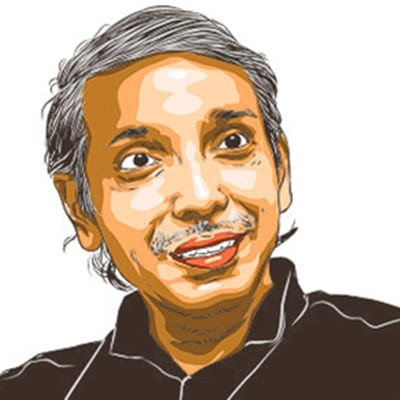Opinion CUET’s critics overlook its inclusive potential
CUET isn’t just an exam; it’s a shift from fragmented access to national inclusion
 Scrapping CUET due to initial hiccups would be like abandoning a national highway because the first few kilometres were uneven (Express File)
Scrapping CUET due to initial hiccups would be like abandoning a national highway because the first few kilometres were uneven (Express File) Let’s take a closer look at the policy rationale behind the introduction of CUET. A handful of elite schools dominated the intake at DU in yesteryears. Students from under-resourced boards and rural schools were locked out, not because they were less capable but because their boards followed a more conservative evaluation. CUET, despite its growing pains, attempts to correct that imbalance.
The claim of 5,000 empty seats in a year isn’t surprising. With CUET’s structured system, students now navigate a wider array of choices across top central universities, which naturally shifts how seats fill up and leaves some spots open in certain colleges. When CUET was introduced in 2022, it wasn’t a knee-jerk response, but a step aligned with the National Education Policy 2020 vision. Concerns around coaching and proxy schools merit serious attention, but the blame cannot be laid at CUET’s doorstep alone. The coaching culture in India has predated CUET for decades. CUET has disrupted this space by designing a test that aligns closely with the NCERT curriculum, making it less dependent on external coaching.
CUET doesn’t dismantle the federal character as claimed by the critics — it recalibrates it. By including regional languages, CUET decentralises access while maintaining a common evaluative baseline. While early hiccups are inevitable, these challenges open the door to real improvements, such as more test centres in remote areas and tailored help for students with disabilities. The accurate measure won’t be this year’s rollout. It is whether future graduates reflect a system that truly values inclusion.
Acknowledging the anxiety caused by shifting dates and delayed admissions is fair. However, in the context of large-scale national exams, occasional rescheduling is part of operational reality. Rather than disrupting Delhi University’s academic calendar, CUET is gradually introducing a unified timeline — something DU has long needed after years of calendar drift, delayed results, and fragmented planning.
“Mop-up” rounds, far from being a sign of system failure, actually recognise the real-life messiness of student choices — adolescents navigating high-stakes decisions deserve second chances, not rigid deadlines. As for the science streams, the real question is whether undergraduate science education has kept pace with student ambition; CUET may streamline access, but revitalising these disciplines calls for better labs, inspired teaching, and fresh curricular thinking. Some say CUET is driving students toward private universities. Perhaps a few students are making that shift. A truly strong public university system won’t collapse under this competition. It will adapt, invest, and elevate the learning experience.
Strengthening NTA’s foundation means investing in better exam tech, harmonising university timelines, and widening the circle of access to students. Calling CUET a disruption overlooks the magnitude of what it’s managing — across more than 250 universities, 13 languages, and lakhs of aspirants navigating multiple subject combinations. The system is evolving with each cycle toward a more responsive and inclusive admission process. Admitting 20 per cent extra students to DU was a step required to make sure no deserving student missed admission. Critics overlook the fact that Indian university calendars were never synchronised. By making admissions following a national timeline, CUET provides an opportunity for academic mobility and efficient scheduling.
Colleges shifting classes online due to a lack of classroom space to experiment with flexible delivery models is perhaps not such a bad thing. The previous DU system privileged a few with high board marks. Now, students from rural areas, tribal-dominated districts and government schools can access the same opportunity pool with a national entrance test. The very idea of a “normative” calendar, “normative” workload, or “normative” admissions model is being challenged, and rightly so. Teaching roles will need redefinition. Technology will have to become an ally. CUET isn’t the problem. It’s the mirror revealing all the things we’ve long postponed fixing.
CUET challenges outdated assumptions that all Class XII marks carry equal weight. It exposes hidden disparities and makes space for a more level field. Clubs, cultural fests, and co-curricular activities are integral to the university experience. However, their functioning has always had to navigate scheduling challenges, faculty availability, and examination pressures. CUET did not invent these constraints. The idea that CUET is tilted toward CBSE doesn’t hold up to closer scrutiny. CUET has subject-specific choices aligned to multiple state syllabi, multilingual papers, and an expanding network of test centres. CUET is evolving into a more inclusive system.
Attributing the dip in female participation in DU entirely to CUET oversimplifies the issue. If paired with clear information campaigns in aspirational districts, CUET can still become a powerful bridge for young women from small towns to access India’s leading universities. CUET has not become a tool of over-centralisation. It is a shared national benchmark with space for regional languages and subject flexibility. The idea of normalising board scores sounds reasonable on paper. The problem is that no formula has truly levelled disparate systems across the more than 60 boards, each with its own curriculum design, marking leniency, and internal politics.
NTA is honestly confronting the paper leak allegations and logistical hiccups. It is working on safeguarding exam integrity. Scrapping CUET due to initial hiccups would be like abandoning a national highway because the first few kilometres were uneven. CUET isn’t just an exam; it’s a shift from fragmented access to national inclusion. It might take a few years to settle. But can we go back to a system that hid its exclusions behind the mask of Class XII scores?
The writer is former chairman, UGC and Former VC, JNU. Views are personal






